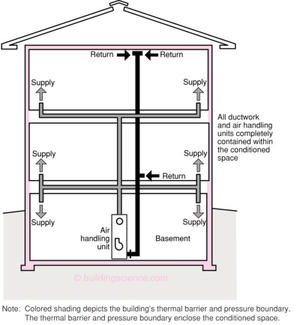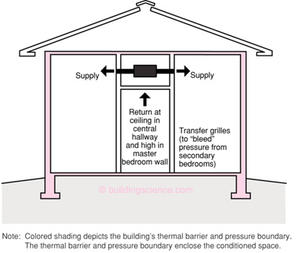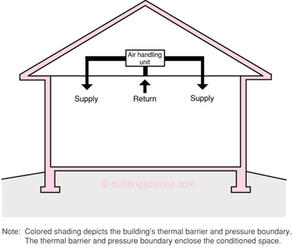The location of the duct system can have a significant impact on the overall performance of the system—both the utility use and the ability to provide comfort. The energy loss from the ducts for forced air heating and cooling systems can be significant, depending on the location of the ducts, and how well the ducts are sealed against air leakage. Though it is conceptually easy to imagine sealed duct systems, tight duct systems are unfortunately all too rare—duct leakage values of 20% of system flow are common. In many houses, the distribution duct work is located either in a vented crawlspace or in a vented attic—effectively outdoors. With the ducts located outside of the thermal envelope of the home, any leakage and conductive losses from the duct work is lost directly to the outside. Even worse, whenever air is leaking out or the ducts due to the system running, air is coming into the house to replace the lost air—resulting in forced air leakage whenever your furnace or air conditioner runs.
Moving the duct work and air handlers inside the thermal enclosure can be used to help prevent this energy loss to the exterior. Alternately, the thermal enclosure can be extended to include areas such as crawlspaces and attic as part of the conditioned space of the house.
In general, the placement of the mechanical equipment will depend on the design of the house. For houses with conditioned crawlspaces and basements, it is often logical to place the air handler or furnace in those locations. For slab-on-grade designs or elevated floors, available space can become a limitation. In these cases, unvented conditioned and semi-conditioned attics provide for a convenient location for the mechanical equipment and ducts. Otherwise, the equipment and / or ducts can be located in a dropped ceiling or in closets.
Consideration for space requirements for the mechanical equipment should be made early in the design.
Ducts in Conditioned Space Details
Figure 1
Vented and Unconditioned Attic
- The air handling unit is located in a conditioned basement
- Low efficiency gas appliances that are prone to spillage or backdrafting are not recommended in this type of application; heat pumps, heat pump water heaters or sealed combustion furnaces and water heaters should be used
- A hot water-to-air coil in an air handling unit can be used to replace the gas furnace/heat exchanger. The coil can be connected to a sealed combustion (or power vented) water heater located within the conditioned space.
- Ductwork is not located in exterior walls or in the vented attic
Figure 2
Vented and Unconditioned Attic with a Dropped Ceiling
- In this approach, exterior wall heights are typically increased to 9-feet or more leaving hallway ceiling heights at 8-feet
- The air handling unit is located in an interior closet and the supply and return ductwork are located in a dropped hallway
- Transfer grilles “bleed” pressure from secondary bedrooms
- Ductwork does not have to extend to building perimeters when thermally efficient windows (low-E, spectrally selective) and thermally efficient (well-insulated 2x6 frome walls with 2” of insulating sheathing) building enclosure construction is used; throw-type registers should be selected
- Low efficiency gas appliances that are prone to spillage or backdrafting are not recommended in this type of application; heat pumps, heat pump water heaters or sealed combustion furnaces and water heaters should be used
- A hot water-to-air coil in an air handling unit can be used to replace the gas furnace/heat exchanger. The coil can be connected to a sealed combustion (or pwer vented) water heater located within the conditioned space.
- Ductwork is not located in exterior walls or in the vented attic
Figure 3
Unvented and Conditioned Attic
- The air handling unit is located in an unvented, conditioned attic; the attic insulation is located at or above the roof deck
- Low efficiency appliances that are prone to spillage or backdrafting are not recommended in this type of application; heat pumps, heat pump water heaters or sealed combustion furnaces and water heaters should be used
- A hot water-to-air in an air handling unit can be used to replace the gas furnace/heat exchanger. The coil can be connected to a sealed combustion (or power vented) water heater located within the conditioned space
- Ductwork is not located in exterior walls



